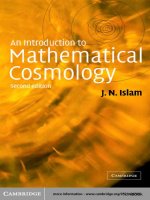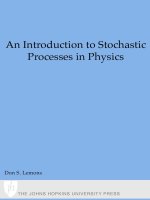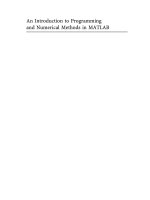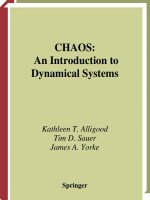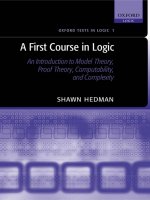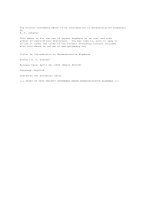- Trang chủ >>
- Khoa Học Tự Nhiên >>
- Vật lý
alligood k.t., yorke j.a, t.d.sauer. chaos.. an introduction to dynamical systems
Bạn đang xem bản rút gọn của tài liệu. Xem và tải ngay bản đầy đủ của tài liệu tại đây (7.05 MB, 612 trang )
CHAOS:
An Introduction to
Dynamical Systems
Kathleen T. Alligood
Tim D. Sauer
James A. Yorke
Springer
C H A O S An Introduction to Dynamical Systems
Springer
New York
Berlin
Heidelberg
Barcelona
Budapest
Hong Kong
London
Milan
Paris
Santa Clara
Singapore
Tokyo
CHAOS
An Intro du ction to Dyna m ical Systems
K
ATHLEEN T. ALLIGOOD
G eorge M ason Un iversity
TIM D. SAUER
G eorge M ason Un iversity
JAMES A. YORKE
Un iversity o f Mar yland
Textbooks in Mathematical Sciences
Series Editors:
Thomas F. Banchoff Jerrold Marsden
Brown University California Institute of Technology
Keith Devlin Stan Wagon
St. Mary’s College Macalester College
Gaston Gonnet
ETH Zentrum, Z
¨
urich
Cover: Rene Magritte, Golconde 1953. 1996 C. Herscovici, Brussels/Artists Rights
Society (ARS), New York. Used by permission of ARS.
Library of Congress Cataloging-in-Publication Data
Alligood, Kathleen T.
Chaos - an introduction to dynamical systems / Kathleen Alligood,
Tim Sauer, James A. Yorke.
p. cm. — (Textbooks in mathematical sciences)
Includes bibliographical references and index.
1. Differentiable dynamical systems. 2. Chaotic behavior in
systems. I. Sauer, Tim. II. Yorke, James A. III. Title. IV. Series.
QA614.8.A44 1996
003
.85—dc20 95-51304
CIP
Printed on acid-free paper.
1996 Springer-Verlag New York, Inc.
All rights reserved. This work may not be translated or copied in whole or in part without
the written permission of the publisher (Springer-Verlag New York, Inc., 175 Fifth Avenue,
New York, NY 10010, USA), except for brief excerpts in connection with reviews or
scholarly analysis. Use in connection with any form of information storage and retrieval,
electronic adaptation, computer software, or by similar or dissimilar methodology now
known or hereafter developed is forbidden.
Production managed by Frank Ganz; manufacturing supervised by Jeffrey Taub.
Photocomposed by Integre Technical Publishing Co., Inc., Albuquerque, NM.
Printed and bound by R.R. Donnelley & Sons, Harrisonburg, VA.
Printed in the United States of America.
9876543(Correctedthirdprinting,2000)
ISBN 0-387-94677-2 SPIN 10778875
Springer-Verlag New York Berlin Heidelberg
A member of BertelsmannSpringer ScienceϩBusiness Media GmbH
Introduction
BACKGROUND
Sir Isaac Newton brought to the world the idea of modeling the motion of
physical systems with equations. It was necessary to invent calculus along the
way, since fundamental equations of motion involve velocities and accelerations,
which are derivatives of position. His greatest single success was his discovery that
the motion of the planets and moons of the solar system resulted from a single
fundamental source: the gravitational attraction of the bodies. He demonstrated
that the observed motion of the planets could be explained by assuming that there
is a gravitational attraction between any two objects, a force that is proportional
to the product of masses and inversely proportional to the square of the distance
between them. The circular, elliptical, and parabolic orbits of astronomy were
v
I NTRODUCTION
no longer fundamental determinants of motion, but were approximations of laws
specified with differential equations. His methods are now used in modeling
motion and change in all areas of science.
Subsequent generations of scientists extended the method of using differ-
ential equations to describe how physical systems evolve. But the method had
a limitation. While the differential equations were sufficient to determine the
behavior—in the sense that solutions of the equations did exist—it was frequently
difficult to figure out what that behavior would be. It was often impossible to write
down solutions in relatively simple algebraic expressions using a finite number of
terms. Series solutions involving infinite sums often would not converge beyond
some finite time.
When solutions could be found, they described very regular motion. Gen-
erations of young scientists learned the sciences from textbooks filled with exam-
ples of differential equations with regular solutions. If the solutions remained in
a bounded region of space, they settled down to either (A) a steady state, often
due to energy loss by friction, or (B) an oscillation that was either periodic or
quasiperiodic, akin to the clocklike motion of the moon and planets. (In the solar
system, there were obviously many different periods. The moon traveled around
the earth in a month, the earth around the sun in about a year, and Jupiter around
the sun in about 11.867 years. Such systems with multiple incommensurable
periods came to be called quasiperiodic.)
Scientists knew of systems which had more complicated behavior, such as
a pot of boiling water, or the molecules of air colliding in a room. However, since
these systems were composed of an immense number of interacting particles, the
complexity of their motions was not held to be surprising.
Around 1975, after three centuries of study, scientists in large numbers
around the world suddenly became aware that there is a third kind of motion, a
type (C) motion, that we now call “chaos”. The new motion is erratic, but not
simply quasiperiodic with a large number of periods, and not necessarily due to
a large number of interacting particles. It is a type of behavior that is possible in
very simple systems.
A small number of mathematicians and physicists were familiar with the
existence of a third type of motion prior to this time. James Clerk Maxwell, who
studied the motion of gas molecules in about 1860, was probably aware that even
a system composed of two colliding gas particles in a box would have neither
motion type A nor B, and that the long term behavior of the motions would for
all practical purposes be unpredictable. He was aware that very small changes
in the initial motion of the particles would result in immense changes in the
trajectories of the molecules, even if they were thought of as hard spheres.
vi
I NTRODUCTION
Maxwell began his famous study of gas laws by investigating individual
collisions. Consider two atoms of equal mass, modeled as hard spheres. Give the
atoms equal but opposite velocities, and assume that their positions are selected
at random in a large three-dimensional region of space. Maxwell showed that if
they collide, all directions of travel will be equally likely after the collision. He
recognized that small changes in initial positions can result in large changes in
outcomes. In a discussion of free will, he suggested that it would be impossible
to test whether a leopard has free will, because one could never compute from a
study of its atoms what the leopard would do. But the chaos of its atoms is limited,
for, as he observed, “No leopard can change its spots!”
Henri Poincar
´
e in 1890 studied highly simplified solar systems of three
bodies and concluded that the motions were sometimes incredibly complicated.
(See Chapter 2). His techniques were applicable to a wide variety of physical
systems. Important further contributions were made by Birkhoff, Cartwright and
Littlewood, Levinson, Kolmogorov and his students, among others. By the 1960s,
there were groups of mathematicians, particularly in Berkeley and in Moscow,
striving to understand this third kind of motion that we now call chaos. But
only with the advent of personal computers, with screens capable of displaying
graphics, have scientists and engineers been able to see that important equations
in their own specialties had such solutions, at least for some ranges of parameters
that appear in the equations.
In the present day, scientists realize that chaotic behavior can be observed
in experiments and in computer models of behavior from all fields of science. The
key requirement is that the system involve a nonlinearity. It is now common for
experiments whose previous anomalous behavior was attributed to experiment
error or noise to be reevaluated for an explanation in these new terms. Taken
together, these new terms form a set of unifying principles, often called dynamical
systems theory, that cross many disciplinary boundaries.
The theory of dynamical systems describes phenomena that are common
to physical and biological systems throughout science. It has benefited greatly
from the collision of ideas from mathematics and these sciences. The goal of
scientists and applied mathematicians is to find nature’s unifying ideas or laws
and to fashion a language to describe these ideas. It is critical to the advancement
of science that exacting standards are applied to what is meant by knowledge.
Beautiful theories can be appreciated for their own sake, but science is a severe
taskmaster. Intriguing ideas are often rejected or ignored because they do not
meet the standards of what is knowledge.
The standards of mathematicians and scientists are rather different. Mathe-
maticians prove theorems. Scientists look atrealistic models. Their approaches are
vii
I NTRODUCTION
somewhat incompatible. The first papers showing chaotic behavior in computer
studies of very simple models were distasteful to both groups. The mathematicians
feared that nothing was proved so nothing was learned. Scientists said that models
without physical quantities like charge, mass, energy, or acceleration could not be
relevant to physical studies. But further reflection led to a change in viewpoints.
Mathematicians found that these computer studies could lead to new ideas that
slowly yielded new theorems. Scientists found that computer studies of much more
complicated models yielded behaviors similar to those of the simplistic models,
and that perhaps the simpler models captured the key phenomena.
Finally, laboratory experiments began to be carried out that showed un-
equivocal evidence of unusual nonlinear effects and chaotic behavior in very
familiar settings. The new dynamical systems concepts showed up in macroscopic
systems such as fluids, common electronic circuits and low-energy lasers that were
previously thought to be fairly well understood using the classical paradigms. In
this sense, the chaotic revolution is quite different than that of relativity, which
shows its effects at high energies and velocities, and quantum theory, whose effects
are submicroscopic. Many demonstrations of chaotic behavior in experiments are
not far from the reader’s experience.
In this book we study this field that is the uncomfortable interface between
mathematics and science. We will look at many pictures produced by computers
and we try to make mathematical sense of them. For example, a computer study of
the driven pendulum in Chapter 2 reveals irregular, persistent, complex behavior
for ten million oscillations. Does this behavior persist for one billion oscillations?
The only way we can find out is to continue the computer study longer. However,
even if it continues its complex behavior throughout our computer study, we
cannot guarantee it would persist forever. Perhaps it stops abruptly after one
trillion oscillations; we do not know for certain. We can prove that there exist
initial positions and velocities of the pendulum that yield complex behavior
forever, but these choices are conceivably quite atypical. There are even simpler
models where we know that such chaotic behavior does persist forever. In this
world, pictures with uncertain messages remain the medium of inspiration.
There is a philosophy of modeling in which we study idealized systems
that have properties that can be closely approximated by physical systems. The
experimentalist takes the view that only quantities that can be measured have
meaning. Yet we can prove that there are beautiful structures that are so infinitely
intricate that they can never be seen experimentally. For example, we will see
immediately in Chapters 1 and 2 the way chaos develops as a physical parameter
like friction is varied. We see infinitely many periodic attractors appearing with
infinitely many periods. This topic is revisited in Chapter 12, where we show
viii
I NTRODUCTION
how this rich bifurcation structure, called a cascade, exists with mathematical
certainty in many systems. This is a mathematical reality that underlies what
the experimentalist can see. We know that as the scientist finds ways to make
the study of a physical system increasingly tractable, more of this mathematical
structure will be revealed. It is there, but often hidden from view by the noise of
the universe. All science is of course dependent on simplistic models. If we study
a vibrating beam, we will generally not model the atoms of which it is made.
If we model the atoms, we will probably not reflect in our model the fact that
the universe has a finite age and that the beam did not exist for all time. And
we do not include in our model (usually) the tidal effects of the stars and the
planets on our vibrating beam. We ignore all these effects so that we can isolate
the implications of a very limited list of concepts.
It is our goal to give an introduction to some of the most intriguing ideas in
dynamics, the ideas we love most. Just as chemistry has its elements and physics
has its elementary particles, dynamics has its fundamental elements: with names
like attractors, basins, saddles, homoclinic points, cascades, and horseshoes. The
ideas in this field are not transparent. As a reader, your ability to work with these
ideas will come from your own effort. We will consider our job to be accomplished
if we can help you learn what to look for in your own studies of dynamical systems
of the world and universe.
ABOUT THE BOOK
As we developed the drafts of this book, we taught six one semester classes at
George Mason University and the University of Maryland. The level is aimed at
undergraduates and beginning graduate students. Typically, we have used parts
of Chapters 1–9 as the core of such a course, spending roughly equal amounts of
time on iterated maps (Chapters 1–6) and differential equations (Chapters 7–9).
Some of the maps we use as examples in the early chapters come from differential
equations, so that their importance in the subject is stressed. The topics of stable
manifolds, bifurcations, and cascades are introduced in the first two chapters and
then developed more fully in the Chapters 10, 11, and 12, respectively. Chapter
13 on time series may be profitably read immediately after Chapter 4 on fractals,
although the concepts of periodic orbit (of a differential equation) and chaotic
attractor will not yet have been formally defined.
The impetus for advances in dynamical systems has come from many
sources: mathematics, theoretical science, computer simulation, and experimen-
ix
I NTRODUCTION
tal science. We have tried to put this book together in a way that would reflect
its wide range of influences.
We present elaborate dissections of the proofs of three deep and important
theorems: The Poincar
´
e-Bendixson Theorem, the Stable Manifold Theorem, and
the Cascade Theorem. Our hope is that including them in this form tempts you
to work through the nitty-gritty details, toward mastery of the building blocks as
well as an appreciation of the completed edifice.
Additionally, each chapter contains a special feature called a Challenge,
in which other famous ideas from dynamics have been divided into a number
of steps with helpful hints. The Challenges tackle subjects from period-three
implies chaos, the cat map, and Sharkovskii’s ordering through synchronization
and renormalization. We apologize in advance for the hints we have given, when
they are of no help or even mislead you; for one person’s hint can be another’s
distraction.
The Computer Experiments are designed to present you with opportunities
to explore dynamics through computer simulation, the venue through which
many of these concepts were first discovered. In each, you are asked to design
and carry out a calculation relevant to an aspect of the dynamics. Virtually all
can be successfully approached with a minimal knowledge of some scientific
programming language. Appendix B provides an introduction to the solution of
differential equations by approximate means, which is necessary for some of the
later Computer Experiments.
If you prefer not to work the Computer Experiments from scratch, your
task can be greatly simplified by using existing software. Several packages
are available. Dynamics: Numerical Explorations by H.E. Nusse and J.A. Yorke
(Springer-Verlag 1994) is the result of programs developed at the University of
Maryland. Dynamics, which includes software for Unix and PC environments,
was used to make many of the pictures in this book. The web site for Dynamics
is www.ipst.umd.edu/dynamics. We can also recommend Differential and
Difference Equations through Computer Experiments by H. Kocak (Springer-Verlag,
1989) for personal computers. A sophisticated package designed for Unix plat-
forms is dstool, developed by J. Guckenheimer and his group at Cornell University.
In the absence of special purpose software, general purpose scientific computing
environments such as Matlab, Maple, and Mathematica will do nicely.
The Lab Visits are short reports on carefully selected laboratory experi-
ments that show how the mathematical concepts of dynamical systems manifest
themselves in real phenomena. We try to impart some flavor of the setting of the
experiment and the considerable expertise and care necessary to tease a new se-
cret from nature. In virtually every case, the experimenters’ findings far surpassed
x
I NTRODUCTION
what we survey in the Lab Visit. We urge you to pursue more accurate and detailed
discussions of these experiments by going straight to the original sources.
ACKNOWLEDGEMENTS
In the course of writing this book, we received valuable feedback from col-
leagues and students too numerous to mention. Suggestions that led to major
improvements in the text were made by Clark Robinson, Eric Kostelich, Ittai
Kan, Karen Brucks, Miguel San Juan, and Brian Hunt, and from students Leon
Poon, Joe Miller, Rolando Castro, Guocheng Yuan, Reena Freedman, Peter Cal-
abrese, Michael Roberts, Shawn Hatch, Joshua Tempkin, Tamara Gibson, Barry
Peratt, and Ed Fine.
We offer special thanks to Tamer Abu-Elfadl, Peggy Beck, Marty Golubitsky,
Eric Luft, Tom Power, Mike Roberts, Steve Schiff, Myong-Hee Sung, Bill Tongue,
Serge Troubetzkoy, and especially Mark Wimbush for pointing out errors in the
first printing.
Kathleen T. Alligood
Tim D. Sauer
Fairfax, VA
James A. Yorke
College Park, MD
xi
Contents
INTRODUCTION v
1ONE-DIMENSIONALMAPS 1
1.1 One-Dimensional Maps 2
1.2 Cobweb Plot: Graphical Representation of an Orbit 5
1.3 Stability of Fixed Points 9
1.4 Periodic Points 13
1.5 The Family of Logistic Maps 17
1.6 The Logistic Map G(x) ϭ 4x(1 Ϫ x)22
1.7 Sensitive Dependence on Initial Conditions 25
1.8 Itineraries 27
C
HALLENGE 1: PERIOD THREE IMPLIES CHAOS 32
E
XERCISES 36
L
AB VISIT 1: BOOM,BUST, AND CHAOS IN THE BEETLE CENSUS 39
xiii
C ONTENTS
2TWO-DIMENSIONALMAPS 43
2.1 Mathematical Models 44
2.2 Sinks, Sources, and Saddles 58
2.3 Linear Maps 62
2.4 Coordinate Changes 67
2.5 Nonlinear Maps and the Jacobian Matrix 68
2.6 Stable and Unstable Manifolds 78
2.7 Matrix Times Circle Equals Ellipse 87
C
HALLENGE 2: COUNTING THE PERIODIC ORBITS OF
LINEAR MAPS ON A TORUS 92
E
XERCISES 98
L
AB VISIT 2: ISTHESOLAR SYSTEM STABLE?99
3 CHAOS 105
3.1 Lyapunov Exponents 106
3.2 Chaotic Orbits 109
3.3 Conjugacy and the Logistic Map 114
3.4 Transition Graphs and Fixed Points 124
3.5 Basins of Attraction 129
C
HALLENGE 3: SHARKOVSKII’S THEOREM 135
E
XERCISES 140
L
AB VISIT 3: PERIODICITY AND CHAOS IN A
CHEMICAL REACTION 143
4 FRACTALS 149
4.1 Cantor Sets 150
4.2 Probabilistic Constructions of Fractals 156
4.3 Fractals from Deterministic Systems 161
4.4 Fractal Basin Boundaries 164
4.5 Fractal Dimension 172
4.6 Computing the Box-Counting Dimension 177
4.7 Correlation Dimension 180
C
HALLENGE 4: FRACTAL BASIN BOUNDARIES AND THE
UNCERTAINTY EXPONENT 183
E
XERCISES 186
L
AB VISIT 4: FRACTAL DIMENSION IN EXPERIMENTS 188
5 CHAOS IN TWO-DIMENSIONAL MAPS 193
5.1 Lyapunov Exponents 194
5.2 Numerical Calculation of Lyapunov Exponents 199
5.3 Lyapunov Dimension 203
5.4 A Two-Dimensional Fixed-Point Theorem 207
5.5 Markov Partitions 212
5.6 The Horseshoe Map 216
xiv
C ONTENTS
CHALLENGE 5: COMPUTER CALCULATIONS AND SHADOWING 222
EXERCISES 226
L
AB VISIT 5: CHAOS IN SIMPLE MECHANICAL DEVICES 228
6 CHAOTIC ATTRACTORS 231
6.1 Forward Limit Sets 233
6.2 Chaotic Attractors 238
6.3 Chaotic Attractors of Expanding Interval Maps 245
6.4 Measure 249
6.5 Natural Measure 253
6.6 Invariant Measure for One-Dimensional Maps 256
C
HALLENGE 6: INVARIANT MEASURE FOR THE LOGISTIC MAP 264
E
XERCISES 266
LAB VISIT 6: FRACTAL SCUM 267
7 D IF FE R E N T IA L E Q U ATION S 2 7 3
7.1 One-Dimensional Linear Differential Equations 275
7.2 One-Dimensional Nonlinear Differential Equations 278
7.3 Linear Differential Equations in More than One Dimension 284
7.4 Nonlinear Systems 294
7.5 Motion in a Potential Field 300
7.6 Lyapunov Functions 304
7.7 Lotka-Volterra Models 309
C
HALLENGE 7: A LIMIT CYCLE IN THE VAN DER POL SYSTEM 316
EXERCISES 321
L
AB VISIT 7: FLY VS .FLY 325
8 PERIODIC ORBITS AND LIMIT SETS 329
8.1 Limit Sets for Planar Differential Equations 331
8.2 Properties of
-Limit Sets 337
8.3 Proof of the Poincar
´
e-Bendixson Theorem 341
C
HALLENGE 8: TWO INCOMMENSURATE FREQUENCIES
FORM A TORUS 350
E
XERCISES 353
LAB VISIT 8: STEADY STATES AND PERIODICITY IN A
SQUID NEURON 355
9 CHAOS IN DIFFERENTIAL EQUATIONS 359
9.1 The Lorenz Attractor 359
9.2 Stability in the Large, Instability in the Small 366
9.3 The R
¨
ossler Attractor 370
9.4 Chua’s Circuit 375
9.5 Forced Oscillators 376
9.6 Lyapunov Exponents in Flows 379
xv
C ONTENTS
CHALLENGE 9: SYNCHRONIZATION OF CHAOTIC ORBITS 387
E
XERCISES 393
L
AB VISIT 9: LASERS IN SYNCHRONIZATION 394
10 STABLE MANIFOLDS AND CRISES 399
10.1 The Stable Manifold Theorem 401
10.2 Homoclinic and Heteroclinic Points 409
10.3 Crises 413
10.4 Proof of the Stable Manifold Theorem 422
10.5 Stable and Unstable Manifolds for Higher Dimensional Maps 430
C
HALLENGE 10: THE LAKES OF WADA 432
E
XERCISES 440
L
AB VISIT 10: THE LEAKY FAUCET:MINOR IRRITATION
OR
CRISIS? 441
11 BIFURCATIONS 447
11.1 Saddle-Node and Period-Doubling Bifurcations 448
11.2 Bifurcation Diagrams 453
11.3 Continuability 460
11.4 Bifurcations of One-Dimensional Maps 464
11.5 Bifurcations in Plane Maps: Area-Contracting Case 468
11.6 Bifurcations in Plane Maps: Area-Preserving Case 471
11.7 Bifurcations in Differential Equations 478
11.8 Hopf Bifurcations 483
C
HALLENGE 11: HAMILTONIAN SYSTEMS AND THE
LYAPUNOV CENTER THEOREM 491
E
XERCISES 494
L
AB VISIT 11: IRON +SULFURIC ACID −→ HOPF
BIFURCATION 496
12 CASCADES 499
12.1 Cascades and 4.669201609 500
12.2 Schematic Bifurcation Diagrams 504
12.3 Generic Bifurcations 510
12.4 The Cascade Theorem 518
C
HALLENGE 12: UNIVERSALITY IN BIFURCATION DIAGRAMS 525
E
XERCISES 531
L
AB VISIT 12: EXPERIMENTAL CASCADES 532
13 STATE RECONSTRUCTION FROM DATA 537
13.1 Delay Plots from Time Series 537
13.2 Delay Coordinates 541
13.3 Embedology 545
C
HALLENGE 13: BOX-COUNTING DIMENSION
AND
INTERSECTION 553
xvi
C ONTENTS
A MATRIX ALGEBRA 557
A.1 Eigenvalues and Eigenvectors 557
A.2 Coordinate Changes 561
A.3 Matrix Times Circle Equals Ellipse 563
B COMPUTER SOLUTION OF ODES 567
B.1 ODE Solvers 568
B.2 Error in Numerical Integration 570
B.3 Adaptive Step-Size Methods 574
ANSWERS AND HINTS TO SELECTED EXERCISES 577
BIBLIOGRAPHY 587
INDEX 595
xvii
C HAPTER O NE
One-Dimensional Maps
T
HE FUNCTION f(x) ϭ 2x is a rule that assigns to each number x a number
twice as large. This is a simple mathematical model. We might imagine that x
denotes the population of bacteria in a laboratory culture and that f(x) denotes
the population one hour later. Then the rule expresses the fact that the population
doubles every hour. If the culture has an initial population of 10,000 bacteria,
then after one hour there will be f(10,000) ϭ 20, 000 bacteria, after two hours
there will be f(f(10,000)) ϭ 40,000 bacteria, and so on.
A dynamical system consists of a set of possible states, together with a
rule that determines the present state in terms of past states. In the previous
paragraph, we discussed a simple dynamical system whose states are population
levels, that change with time under the rule x
n
ϭ f(x
nϪ1
) ϭ 2x
nϪ1
.Herethe
variable n stands for time, and x
n
designates the population at time n. We will
1
O NE-DIMENSIONAL M APS
require that the rule be deterministic, which means that we can determine the
present state (population, for example) uniquely from the past states.
No randomness is allowed in our definition of a deterministic dynamical
system. A possible mathematical model for the price of gold as a function of time
would be to predict today’s price to be yesterday’s price plus or minus one dollar,
with the two possibilities equally likely. Instead of a dynamical system, this model
would be called a random,orstochastic, process. A typical realization of such a
model could be achieved by flipping a fair coin each day to determine the new
price. This type of model is not deterministic, and is ruled out by our definition
of dynamical system.
We will emphasize two types of dynamical systems. If the rule is applied
at discrete times, it is called a discrete-time dynamical system. A discrete-time
system takes the current state as input and updates the situation by producing a
new state as output. By the state of the system, we mean whatever information
is needed so that the rule may be applied. In the first example above, the state is
the population size. The rule replaces the current population with the population
one hour later. We will spend most of Chapter 1 examining discrete-time systems,
also called maps.
The other important type of dynamical system is essentially the limit of
discrete systems with smaller and smaller updating times. The governing rule in
that case becomes a set of differential equations, and the term continuous-time
dynamical system is sometimes used. Many of the phenomena we want to explain
are easier to describe and understand in the context of maps; however, since the
time of Newton the scientific view has been that nature has arranged itself to
be most easily modeled by differential equations. After studying discrete systems
thoroughly, we will turn to continuous systems in Chapter 7.
1.1 ONE-DIMENSIONAL MAPS
One of the goals of science is to predict how a system will evolve as time progresses.
In our first example, the population evolves by a single rule. The output of the
rule is used as the input value for the next hour, and the same rule of doubling is
applied again. The evolution of this dynamical process is reflected by composition
of the function f.Definef
2
(x) ϭ f(f(x)) and in general, define f
k
(x)tobethe
result of applying the function f to the initial state k times. Given an initial
value of x, we want to know about f
k
(x) for large k. For the above example, it is
clear that if the initial value of x is greater than zero, the population will grow
without bound. This type of expansion, in which the population is multiplied by
2
1.1 ONE-DIMENSIONAL M APS
a constant factor per unit of time, is called exponential growth. The factor in this
example is 2.
W HY STUDY M ODELS?
W
e study models because they suggest how real-world processes be-
have. In this chapter we study extremely simple models.
Every model of a physical process is at best an idealization. The goal
of a model is to capture some feature of the physical process. The
feature we want to capture now is the patterns of points on an orbit.
In particular, we will find that the patterns are sometimes simple, and
sometimes quite complicated, or “chaotic”, even for simple maps.
The question to ask about a model is whether the behavior it exhibits
is because of its simplifications or if it captures the behavior despite
the simplifications. Modeling reality too closely may result in an
intractable model about which little can be learned. Model building
is an art. Here we try to get a handle on possible behaviors of maps
by considering the simplest ones.
The fact that real habitats have finite resources lies in opposition to the
concept of exponential population increase. From the time of Malthus (Malthus,
1798), the fact that there are limits to growth has been well appreciated. Popula-
tion growth corresponding to multiplication by a constant factor cannot continue
forever. At some point the resources of the environment will become compro-
mised by the increased population, and the growth will slow to something less
than exponential.
In other words, although the rule f(x) ϭ 2x may be correct for a certain range
of populations, it may lose its applicability in other ranges. An improved model,
to be used for a resource-limited population, might be given by g(x) ϭ 2x(1 Ϫ x),
where x is measured in millions. In this model, the initial population of 10,000
corresponds to x ϭ .01 million. When the population x is small, the factor (1 Ϫ x)
is close to one, and g(x) closely resembles the doubling function f(x). On the other
hand, if the population x is far from zero, then g(x) is no longer proportional to
the population x but to the product of x and the “remaining space” (1 Ϫ x). This is
3
O NE-DIMENSIONAL M APS
a nonlinear effect, and the model given by g(x) is an example of a logistic growth
model.
Using a calculator, investigate the difference in outcomes imposed by the
models f(x)andg(x). Start with a small value, say x ϭ 0.01, and compute f
k
(x)
and g
k
(x) for successive values of k. The results for the models are shown in
Table 1.1. One can see that for g(x), there is computational evidence that the
population approaches an eventual limiting size, which we would call a steady-
state population for the model g(x). Later in this section, using some elementary
calculus, we’ll see how to verify this conjecture (Theorem 1.5).
There are obvious differences between the behavior of the population size
under the two models, f(x)andg(x). Under the dynamical system f(x), the starting
population size x ϭ 0.01 results in arbitrarily large populations as time progresses.
Under the system g(x), the same starting size x ϭ 0.01 progresses in a strikingly
similar way at first, approximately doubling each hour. Eventually, however, a
limiting size is reached. In this case, the population saturates at x ϭ 0.50 (one-
half million), and then never changes again.
So one great improvement of the logistic model g(x) is that populations
can have a finite limit. But there is a second improvement contained in g(x). If
n f
n
(
x
)
g
n
(
x
)
0 0.0100000000 0.0100000000
1 0.0200000000 0.0198000000
2 0.0400000000 0.0388159200
3 0.0800000000 0.0746184887
4 0.1600000000 0.1381011397
5 0.3200000000 0.2380584298
6 0.6400000000 0.3627732276
7 1.2800000000 0.4623376259
8 2.5600000000 0.4971630912
9 5.1200000000 0.4999839039
10 10.2400000000 0.4999999995
11 20.4800000000 0.5000000000
12 40.9600000000 0.5000000000
Table 1.1 Comparison of exponential growth model
f
(
x
) ؍ 2
x
to logistic
growth model
g
(
x
) ؍ 2
x
(1 ؊
x
).
The exponential model explodes, while the logistic model approaches a steady state.
4
1.2 COBWEB P LOT:GRAPHICAL R EPRESENTATION OF AN O RBIT
we use starting populations other than x ϭ 0.01, the same limiting population
x ϭ 0.50 will be achieved.
➮ COMPUTER EXPERIMENT 1.1
Confirm the fact that populations evolving under the rule g(x) ϭ 2x(1 Ϫ x)
prefer to reach the population 0.5. Use a calculator or computer program, and try
starting populations x
0
between 0.0and1.0. Calculate x
1
ϭ g(x
0
),x
2
ϭ g(x
1
),
etc. and allow the population to reach a limiting size. You will find that the size
x ϭ 0.50 eventually “attracts” any of these starting populations.
Our numerical experiment suggests that this population model has a natural
built-in carrying capacity. This property corresponds to one of the many ways
that scientists believe populations should behave—that they reach a steady-state
which is somehow compatible with the available environmental resources. The
limiting population x ϭ 0.50 for the logistic model is an example of a fixed point
of a discrete-time dynamical system.
Definition 1.1 A function whose domain (input) space and range (out-
put) space are the same will be called a map.Letx be a point and let f beamap.
The orbit of x under f is the set of points ͕x, f(x),f
2
(x), ͖. The starting point
x for the orbit is called the initial value of the orbit. A point p is a fixed point of
the map f if f(p) ϭ p.
For example, the function g(x) ϭ 2x(1 Ϫ x) from the real line to itself is a
map. The orbit of x ϭ 0.01 under g is ͕0.01, 0.0198, 0.0388, ͖, and the fixed
points of g are x ϭ 0andx ϭ 1 2.
1.2 COBWEB PLOT:GRAPHICAL
REPRESENTATION OF AN ORBIT
For a map of the real line, a rough plot of an orbit—called a cobweb plot—can be
made using the following graphical technique. Sketch the graph of the function
f together with the diagonal line y ϭ x. In Figure 1.1, the example f(x) ϭ 2x and
the diagonal are sketched. The first thing that is clear from such a picture is the
location of fixed points of f. At any intersection of y ϭ f(x) with the line y ϭ x,
5
O NE-DIMENSIONAL M APS
x.04
.04
.02
.02
.06
.08
f(x) = 2x
y = x
Figure 1.1 An orbit of
f
(
x
) ؍ 2
x
.
The dotted line is a cobweb plot, a path that illustrates the production of a trajectory.
the input value x and the output f(x) are identical, so such an x is a fixed point.
Figure 1.1 shows that the only fixed point of f(x) ϭ 2x is x ϭ 0.
Sketching the orbit of a given initial condition is done as follows. Starting
with the input value x ϭ .01, the output f(.01) is found by plotting the value
of the function above .01. In Figure 1.1, the output value is .02. Next, to find
f(.02), it is necessary to consider .02 as the new input value. In order to turn an
output value into an input value, draw a horizontal line from the input–output
pair (.01,.02) to the diagonal line y ϭ x. In Figure 1.1, there is a vertical dotted
line segment starting at x ϭ .01, representing the function evaluation, and then
a horizontal dotted segment which effectively turns the output into an input so
that the process can be repeated.
Then start over with the new value x ϭ .02, and draw a new pair of vertical
and horizontal dotted segments. We find f(f(.01)) ϭ f(.02) ϭ .04 on the graph
of f, and move horizontally to move output to the input position. Continuing in
this way, a graphical history of the orbit ͕.01,.02,.04, ͖ is constructed by the
path of dotted line segments.
E XAMPLE 1.2
A more interesting example is the map g(x) ϭ 2x(1 Ϫ x). First we find fixed
points by solving the equation x ϭ 2x(1 Ϫ x). There are two solutions, x ϭ 0
6
1.2 COBWEB P LOT:GRAPHICAL R EPRESENTATION OF AN O RBIT
C OBWEB P LOT
A cobweb plot illustrates convergence to an attracting fixed point of
g(x) ϭ 2x(1 Ϫ x). Let x
0
ϭ 0.1 be the initial condition. Then the
first iterate is x
1
ϭ g(x
0
) ϭ 0.18. Note that the point (x
0
,x
1
) lies on
the function graph, and (x
1
,x
1
) lies on the diagonal line. Connect
these points with a horizontal dotted line to make a path. Then find
x
2
ϭ g(x
1
) ϭ 0.2952, and continue the path with a vertical dotted
line to (x
1
,x
2
) and with a horizontal dotted line to (x
2
,x
2
). An entire
orbit can be mapped out this way.
In this case it is clear from the geometry that the orbit we are follow-
ing will converge to the intersection of the curve and the diagonal,
x ϭ 1 2. What happens if instead we start with x
0
ϭ 0.8? These are
examples of simple cobweb plots. They can be much more compli-
cated, as we shall see later.
0.1
0.5
0.5
g(x) = 2x(1-x)
x
y
Figure 1.2 A cobweb plot for an orbit of
g
(
x
) ؍ 2
x
(1 ؊
x
).
The orbit with initial value .1 converges to the sink at .5.
7
O NE-DIMENSIONAL M APS
and x ϭ 1 2, which are the two fixed points of g. Contrast this with a linear
map which, except for the case of the identity f(x) ϭ x, has only one fixed point
x ϭ 0. What is the behavior of orbits of g? The graphical representation of the
orbit with initial value x ϭ 0.1 is drawn in Figure 1.2. It is clear from the figure
that the orbit, instead of diverging to infinity as in Figure 1.1, is converging to the
fixed point x ϭ 1 2. Thus the orbit with initial condition x ϭ 0.1 gets stuck, and
cannot move beyond the fixed point x ϭ 0.5. A simple rule of thumb for following
the graphical representation of an orbit: If the graph is above the diagonal line
y ϭ x, the orbit will move to the right; if the graph is below the line, the orbit
moves to the left.
E XAMPLE 1.3
Let f be the map of ޒ given by f(x) ϭ (3x Ϫ x
3
) 2. Figure 1.3 shows
a graphical representations of two orbits, with initial values x ϭ 1.6and1.8,
respectively. The former orbit appears to converge to the fixed point x ϭ 1asthe
map is iterated; the latter converges to the fixed point x ϭϪ1.
-1
1
1
-1
1.8
x
y
1.6
f(x) =
3x - x
3
2
Figure 1.3 A cobweb plot for two orbits of
f
(
x
) ؍ (3
x
؊
x
3
) 2.
The orbit with initial value 1.6 converges to the sink at 1; the orbit with initial
value 1.8 converges to the sink at Ϫ1.
8
